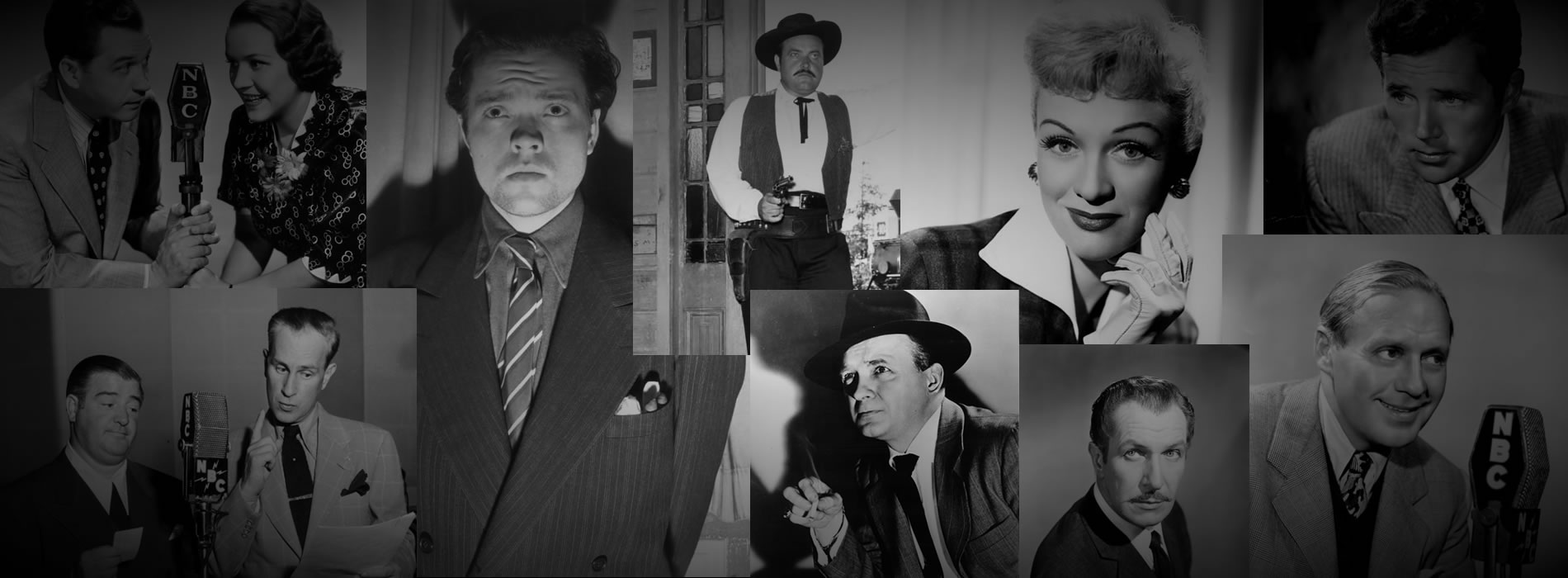
NEWSLETTER | VOL. 17, September 2022
Welcome to this month’s edition of The Hollywood 360 Newsletter, your place to get all the news on upcoming shows, schedule and interesting facts from your H360 team!
Carl’s Corner
by Carl Amari
Hello everyone – here’s the Hollywood 360 newsletter, September 2022 / Vol. 17. As someone on our mailing list, you’ll receive the most current newsletter via email on the first day of every month. If you don’t receive it by the end of the first day of the month, check your spam folder as they often end up there. If it is not in your regular email box or in your spam folder, contact me at carlpamari@gmail.com and I’ll forward you a copy. The monthly Hollywood 360 newsletter contains articles from my team and the full month’s detailed schedule of classic radio shows that we will be airing on Hollywood 360. Each month I’ll provide an article on one of the classic radio shows we’ll present on Hollywood 360. This month, we’ll be airing an episode of The Jack Benny Program the week of September 24th, so here’s an article on Jack Benny, one of the greatest comedians of all-time. Enjoy!
SPOTLIGHT ON JACK BENNY
By Carl Amari and Martin Grams
Ask comedians today (including Jerry Seinfeld) of their career inspiration and many will name Jack Benny. For over half a century, Jack Benny was one of the great comics of stage, screen, radio and television. He was the past master of the long take and knew how to milk a laugh. On his long-running radio and television programs, Benny was depicted as a miser who hoarded every penny he made. Year after year he denied he was older than 39 and honed his persona of a vain and devious penny-pincher — which was in stark contrast to the warm and generous human being he was in real life. Benny knew he could be funny by applying a simple policy: let others around him deliver the punch lines. He discovered early on that it didn’t matter who got the laughs on The Jack Benny Program as long as people were talking about how funny it was. Perhaps this is why Variety once labeled him “television’s straight man.”
The secret of Jack Benny was the understanding, which existed between him and his audience, a conditioned telepathy that enabled him to be funny without being obvious. Eddie “Rochester” Anderson (an African American comedian who portrayed Benny’s butler and valet) often got the best of his employer… an unheard of position for most African Americans at the time.
Benny’s smooth humor was of the highest order, never telling a dirty joke… well, rarely. In one TV episode the comedian went down to his underground vault to withdraw a few dollars and is greeted by the old timer who stood guard at the door. It’s obvious the old man has been in the underground vault for decades when he asks Benny what it is like on the surface. “Well, it’s autumn and the leaves are falling,” Benny explains. The old man displays an odd look on his face and expresses how that would be real nice. “Oh no,” Benny calmly explains. “People are wearing clothes now.” 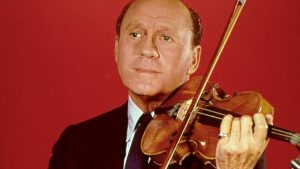
Born Benjamin Kubelsky in 1894, Benny grew up in Waukegan, Illinois and began studying the violin at the age of six. His parents dreamed he’d be a great classical violinist. By age 17, he was performing on vaudeville. In 1929, Benny signed a Hollywood contract and made his screen debut as a comedic emcee in The Hollywood Revue of 1929. In 1932, Benny made his radio debut on Ed Sullivan’s program and became an overnight sensation. Before the end of the calendar year, Benny was signed to star on a weekly radio program on NBC.
Throughout the thirties, Benny was aided by a supporting cast that included announcer Don Wilson, singer Dennis Day and Benny’s real-life wife, Mary Livingstone. His Sunday night radio program was among the top ten for more than a decade but his success was not limited to the stage and radio. In the late 1930’s Paramount Pictures signed Benny to a multi-picture deal. He starred in such classics as Man About Town (1939), Buck Benny Rides Again (1940) and Love Thy Neighbor (1940) — the latter of which highlighted a bitter rival between Jack Benny and another radio comedian, Fred Allen. The two exchanged unkind words on each other’s radio programs, generating a great deal of laughs and publicity. In truth, the rivalry was a farce in the same vein later reproduced by Bob Hope and Bing Crosby.
A staple on NBC radio for 16 years, Jack Benny made headlines when he signed an unprecedented contract with rival network CBS. In late 1948, CBS hoped to dominate the broadcasting industry by successfully luring Jack Benny away from his long-term NBC contract. With television on the horizon, CBS knew that offering stock options and a high salary, was what it would take to woo Benny and they were right. They later convinced him to appear on CBS television in a series of monthly specials beginning in 1950. By 1953, The Jack Benny Program was a weekly television fan-favorite. Benny and his radio cast transitioned perfectly to the video medium managing to generate laughs on both radio and television. With audiences abandoning radio for TV, Benny dropped his radio series in 1955, continuing with the weekly television program for another decade.
After reviewing countless episodes of Benny’s classic television program, one word best describes the situation comedy: brilliance. Perhaps his most famous gag was the night he walked home and was confronted out of the darkness by a robber who barked: “Your money or your life.” Benny, hands in the air, did a slow deadpan look towards the audience. After a few seconds of silence from the victim, the robber with gun in hand repeated his demand. “Look Bud, I said your money or your life!” “I’m thinking it over!” responded Benny.
To add to his resume of laughs, Benny made a guest appearance on the popular quiz program, The $64,000 Question. After answering the first question correctly, Jack Benny quit and took home the $1.00 prize. In the summer of 1965, Jack Benny decided it was time to retire from television. This decision was later reinforced when one evening, toward the end of his television run, he was waiting for his pre-recorded show to air and began watching Bonanza, which started a half-hour before his show on a rival network. He wound up missing his own TV show and later remarked, “If I won’t even watch me, what chance do I have?”
Throughout the late sixties and early seventies, Jack Benny was convinced by NBC to star in a series of “farewell” television specials, with celebrity guests including: Bob Hope, Lucille Ball, George Burns and Dinah Shore, among others. The cast of his radio and television program also made appearances, recounting their fond days of weekly comedic breakups. On one of those television specials, Benny was presented an award and the comedian remarked: “I don’t deserve this, but I have arthritis and I don’t deserve that, either.”
Through the years, Benny and his program garnered eight Emmys. Jack Benny, the accomplished violinist, performed with more than 80 symphony orchestras raising millions for charities. During World War II, he entertained U.S. troops by performing in Africa, the Middle East, Italy, Australia and the Pacific Islands, among many other places. In 1951 he spent six weeks in Korea entertaining the troops.
At his funeral in 1974, George Burns began the eulogy and broke down. Bob Hope rose to the podium and in a shaky voice honored the comedian by finishing the text, “for a man who was the undisputed master of comedy timing, you’d have to say that this was the only time when Jack Benny’s timing was all wrong. He left us much too soon.”
LEND ME YOUR EARS | THIS MONTH’S SONG: DANCING QUEEN, by ABBA
by Lisa Wolf
“We knew immediately it was going to be massive… I knew it was absolutely the best song ABBA had ever done.” ~ ABBA singer Agnetha Fältskog
 You are the dancing queen
You are the dancing queen
Young and sweet, only seventeen
Dancing queen
Feel the beat from the tambourine, oh yeah
Few songs are as universally beloved as “Dancing Queen” by ABBA. Even Carl recognized this dance song on our Hollywood 360 “Name That Tune” segment!
The recording sessions for “Dancing Queen” began in 1975, a year before its initial release. The demo was called “Boogaloo”. They delayed the song for a year so that it would come out right before their fourth album, Arrival. The single topped the charts in 15 countries, including the U.S. Of the 14 ABBA songs that have made the Top 40, “Dancing Queen” was their only number 1 hit.
For their 1980 Spanish-language compilation Gracias Por La Música, ABBA recorded a Spanish version of the song, renamed ‘Reina Danzante’. Click here to listen on YouTube.
In 2008, the musical ‘Mamma Mia!’ was released, based on the songs of ABBA. Meryl Streep, Christine Baranski and Julie Walters performed this song while dancing through the city. 
Click here to listen on Youtube.
Most recently, “Dancing Queen” was featured in the film ‘Mamma Mia! Here We Go Again’ released in 2018. The song was performed by a star-studded cast including Pierce Brosnan, Christine Baranski, Colin Firth, Stellan Skarsgård and Amanda Seyfried.
Click here to listen on Youtube.
“Dancing Queen” has spanned multiple generations and is dubbed the best pop song ever!
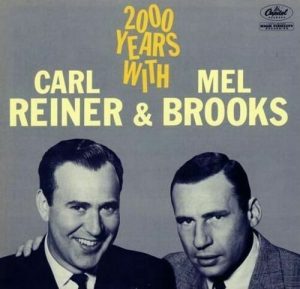 The Timeless Comedy of the 2000 Year Old Man: The 200 Year Old Man
The Timeless Comedy of the 2000 Year Old Man: The 200 Year Old Man
by Barry Richert
Carl Reiner and Mel Brooks can be described as comedy legends whether you’re talking about them separately or together. Individually, it’s hard to know where to start listing their accomplishments. You could mention that Reiner created The Dick Van Dyke Show and wrote and/or directed films like Enter Laughing; Where’s Poppa?; Oh, God!; and The Jerk. Brooks, meanwhile, co-created Get Smart and wrote and/or directed such classic comedy films as The Producers, Blazing Saddles, Young Frankenstein, and Spaceballs. But long before any of those projects came to fruition, Reiner and Brooks teamed up to create one of the most beloved comedy routines of all time: The 2000 Year Old Man.
Carl Reiner and Mel Brooks met while working together on the writing staff of Your Show of Shows—a 1950s television variety series starring comedian Sid Caesar. It was in the writers’ room of that show that the 2000 Year Old Man was born. One day Carl Reiner—seeking to parody the news interview program We the People Speak—pointed at Brooks and said, “Here with us today, ladies and gentlemen, is a man who was actually at the scene of the crucifixion two thousand years ago. Isn’t that true sir?” To which Brooks responded with a world-weary, “Oooh boy.” The writers’ room exploded with laughter. “You knew Jesus?” Reiner continued. “Yeah,” Brooks answered, “Thin lad, wore sandals, long hair, walked around with eleven other guys. Always came into the store, never bought anything. Always asked for water.” As the two continued to riff, the 2000 Year Old Man took shape.
The act proved so popular that the duo started performing it at parties, including one lavish, well-attended Hollywood affair thrown by Broadway producer Joe Fields. In his autobiography, All About Me!, Mel Brooks recalls, “Edward G. Robinson came up to us afterward and said, ‘Make a play out of it. I want to play that thousand-year-old man!’ Then George Burns came over and asked, ‘Is there an album?’ And when we said no, he said, ‘Well, you better put it on an album otherwise I’m gonna steal it.'” 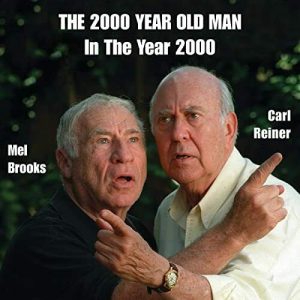
Steve Allen was at the same party and urged Reiner and Brooks to record an album. Despite their reluctance—they felt the routine was for friends and might be too “inside”—Allen arranged free recording time at World Pacific, a studio he co-owned. That recording session became the album 2000 Years with Carl Reiner and Mel Brooks, released in 1961. Besides the 2000 Year Old Man, the record included Reiner interviewing Brooks as a too-hip-for-the-room teen singing sensation, an assortment of eccentric coffee house occupants, and a plantation owner in Argentina with a German accent and a suspiciously exhaustive knowledge of Nazi history. All of them displayed Reiner’s adeptness as a straight man and Brooks’ mastery of comic improvisation. The album was nominated for a Grammy, and Reiner and Brooks were soon making appearances on television, including The Steve Allen Show, The Hollywood Palace, and The Ed Sullivan Show.
A second album, 2000 and One Years with Carl Reiner and Mel Brooks, was released in 1962, and featured a thirteen-minute interview with Brooks’ supercentenarian. The remaining tracks comprised Brooks being interviewed as various oddball characters, including The Third Best Poet and The Tax Expert (author of “Taxes, Taxes, Taxes. What Do They Want From Us?”). One track could be considered the inverse response to the 2000 Year Old Man—The Two Hour Old Baby featured Brooks as a newborn with the power of speech.
In 1963, the third album, Carl Reiner and Mel Brooks at the Cannes Film Festival, was released, recorded live at the infamous French gala. One of the tracks put Brooks’ versatility with accents on full display as he portrayed Adolph Hartner, the German representative from the Narzi Film Company; cockney filmmaker Tippy Skittles; and Italian director Federico Fettucine. Side 2 began with Reiner interviewing the now 2000 and Two Year Old Man, who—among other subjects—holds forth on his definition of comedy: “It’s a point of view. To me, tragedy is if I cut my finger; that’s tragedy! It bleeds and I’ll cry and I’ll run around and I’ll go into Mt. Sinai for a day-and-a-half. I’m very nervous about it! And to me, comedy is if you walk into an open sewer and die—what do I care? That’s comedy!”
It would be ten years before Reiner and Brooks recorded a fourth album, but when they did, it consisted solely of interview material featuring Brooks’ venerable raconteur. In 1973, Warner Brothers Records released 2000 and Thirteen. By now, the duo had perfected the routine and Reiner knew how to draw the funniest material out of Brooks. In the documentary Excavating the 2000 Year Old Man, Brooks remembers, “Carl is a wonderful combination of belief and disbelief. Sometimes he goes along with me when I say the most incomprehensible and ridiculous things…and then I will say something rather simple and he’ll say, ‘I find that hard to believe, sir,’ and he chases me into a corner, and I’m always best, I think, when I’m a little cornered rat.”
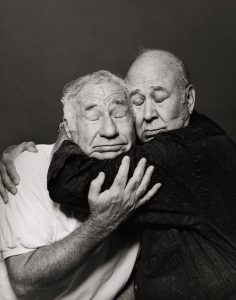 In January of 1975, a half-hour animated TV special called The 2000 Year Old Man aired on CBS. Directed by one-time Disney animator Leo Salkin, the special used material from the previously released albums for its audio track. The special was subsequently released on home video and at this writing is available on YouTube. A companion book featured a transcript of the routines with illustrations from the TV special.
In January of 1975, a half-hour animated TV special called The 2000 Year Old Man aired on CBS. Directed by one-time Disney animator Leo Salkin, the special used material from the previously released albums for its audio track. The special was subsequently released on home video and at this writing is available on YouTube. A companion book featured a transcript of the routines with illustrations from the TV special.
The fifth and final album, The 2000 Year Old Man in the Year 2000, came out in 1997 and was released in tandem with a book featuring the same title. It had been 24 years since the release of 2000 and Thirteen. Reiner and Brooks’ voices were a bit timeworn, the banter slightly less hurried. But the humor was sharper than ever, whether Brooks was waxing nostalgic about a favorite childhood book (“See Moses Run”) or describing a hat shop he once owned (Yarmulkes Galore!). The album sold well and won a Grammy for Best Spoken Comedy Album, proving the timelessness of Reiner and Brooks’ creation.
In All About Me!, Brooks revealed the appeal of playing the ancient storyteller for so many years: “Part of my motive for doing the 2000 Year Old Man was to preserve the Yiddish dialect and the sounds that I grew up with. I was doing my grandparents. My father’s father and mother, and my mother’s father, and their friends . . . He’s the Eastern European immigrant Jew, pronouncing himself forcefully, struggling to make it in America. He’s got to know all the answers, because it’s about survival.”
In his 2003 memoir, My Anecdotal Life, Carl Reiner pointed out, “Growing up in Brooklyn and listening to his uncles, his neighbors, and the shopkeepers talk and argue, Mel, blessed with a good ear for music, had no difficulty absorbing the lilting, Middle European Yiddish accent. . . Our audiences were always . . . happy to hear the Old Man tell intimate stories of his involvements with Joan of Arc, Helen of Troy, and Murray, the discoverer of ladies.” With Reiner’s death in 2020, we likely won’t hear any more recollections from the 2000 Year Old Man. But the five albums recorded by Reiner and Brooks ensure that we’ll be laughing at his past anecdotes for . . . well, another 2000 years.

FRANK STRIKER: ONE MORE RIVER
by Martin Grams
The origin of this novel dates back to September 1945, when Striker penned a four-episode story arc on The Lone Ranger radio program, concerning The Camel Brigade, a project commissioned by the U.S. Army. From 1857 to 1860, the feasibility of using camels for military purposes on the western deserts was tested, with encouraging results, at and near Fort Davis in Southwest Texas. The United States National Museum has on display the mounted skeleton of a camel that died at Fort Tejon, California. This is the only remaining physical evidence of the War Department’s Camel Brigade. 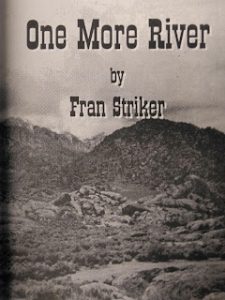
Jefferson Davis fought as a colonel during the war against Mexico, then went to Congress as a United States Senator from Mississippi. In Washington he spent much of his time interviewing military officials in the hope of finding a means to speed the delivery of supplies to the isolated outposts in the southwestern frontier. To connect the forts strung out across the Indian country, Army sentiment favored the construction of a road from San Antonio to Southern California. Senator Davis knew that congress would reject such a proposal because of the high cost and because the road would have to be built under conditions of combat with hostile Indians. He favored a suggestion that came from major Henry C. Wayne. Wayne had read about the dromedary artillery used by the French Army in Algeria. He believed that camels would solve the problem of transportation in the Southwest. Senator Davis, after exhaustive research and study, plunged whole-heartedly into plans for a camel brigade.
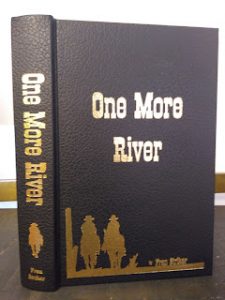 Striker later recycled the historic details, added a romantic triangle between two men and one beautiful woman, and fashioned a new novel about The Camel Brigade. One More River contained no reference to The Lone Ranger and Tonto, and avoided the three criminal elements from the 1948 Lone Ranger novel to form a more adult approach involving murder, torture and bloodshed. the Striker novel borrowed many historical elements and figures for use in One More River, to create what followed the formula of a 1950s Universal Studios Technicolor western. Names of fictional characters from The Lone Ranger radio programs were recycled, as was subplots from the September 1945 radio story arc. The torments and privations that taxed human endurance to the limit — ranging from hostile Indians, dying of thirst in the desert, to men killing each other in an effort to survive — trying hope and despair, famine and feast, salvation and violent death — the wagon train and cavalry company from Fort Defiance went through numerous escapades to cross the summer desert and the Colorado River. The novel comes recommended if you can find a copy. Three different printings (hardcover and paperback) exist and the price is not steep (no doubt because of the lack of demand for such a novel). Fans of The Lone Ranger have often expressed surprise when they learn that Striker wrote a non-Lone Ranger western novel. If you are a fan of western fiction, this is perhaps one of the best I have read in more than a decade.
Striker later recycled the historic details, added a romantic triangle between two men and one beautiful woman, and fashioned a new novel about The Camel Brigade. One More River contained no reference to The Lone Ranger and Tonto, and avoided the three criminal elements from the 1948 Lone Ranger novel to form a more adult approach involving murder, torture and bloodshed. the Striker novel borrowed many historical elements and figures for use in One More River, to create what followed the formula of a 1950s Universal Studios Technicolor western. Names of fictional characters from The Lone Ranger radio programs were recycled, as was subplots from the September 1945 radio story arc. The torments and privations that taxed human endurance to the limit — ranging from hostile Indians, dying of thirst in the desert, to men killing each other in an effort to survive — trying hope and despair, famine and feast, salvation and violent death — the wagon train and cavalry company from Fort Defiance went through numerous escapades to cross the summer desert and the Colorado River. The novel comes recommended if you can find a copy. Three different printings (hardcover and paperback) exist and the price is not steep (no doubt because of the lack of demand for such a novel). Fans of The Lone Ranger have often expressed surprise when they learn that Striker wrote a non-Lone Ranger western novel. If you are a fan of western fiction, this is perhaps one of the best I have read in more than a decade.
The First Lady of Sound Effects
by Karl Schadow
Along with the men who provided the sound effects during Radio’s Golden Age was a unique individual whose career had commenced during the medium’s infancy of the 1920s. This person was responsible for many innovations in the field and would become chief of the sound effects department of a major broadcasting network. Nearly forgotten today, Ora Nichols was a pioneer in radio.
Born Aurore Dolores Daigle in Springfield, Massachusetts, she studied music and was a pianist in a local girls band. While in Springfield, she met and married fellow musician, violinist Arthur Nichols. Together they performed in vaudeville and then turned to providing music and later sound effects for silent films. The duo then entered radio in New York City with the Judson Radio Program Corporation during the mid 1920s. They also performed free-lance work for both NBC and CBS before hired by the latter network full time in 1928.
Arthur Nichols died suddenly of heart disease in 1931. Ora continued working at the network on such shows as Buck Rogers in the 25th Century where she made the sound of the space ships using common air-conditioning equipment. Hailed by producers of The March of Time for constructing ingenious sounds, she was promoted to head the CBS Sound Effects Department. Additional programs benefitting from her expertise included 45 Minutes in Hollywood and Roses & Drums.
A report in Radio Stars (December 1934) hailed her as one of The Nine Greatest Women In Radio. The list included such luminaries as Jessica Dragonette, Kate Smith and Gracie Allen. By 1936 she stepped down as the department’s head, thus was able to devote work to her true passion of creating and developing new effects.
![]() Her participation was requested by many top entertainers in the field including Orson Welles. A famous story from The War of the Worlds broadcast noted that she walked out (with her assistant) on radio’s Boy Wonder during a rehearsal after being told in no uncertain terms how to perform effects. She demanded and received an apology from Welles and returned to her duties.
Her participation was requested by many top entertainers in the field including Orson Welles. A famous story from The War of the Worlds broadcast noted that she walked out (with her assistant) on radio’s Boy Wonder during a rehearsal after being told in no uncertain terms how to perform effects. She demanded and received an apology from Welles and returned to her duties.
Not only did she work the big dramatic night-time series including The Mercury Theatre on the Air and The Columbia Workshop, but also soap operas including Bright Horizon and Big Sister. A 1940 press release stated that her greatest challenge was creating the crashing bridges effect for Welles’ production of “The Bridge of San Luis Rey.”
She acquired the nickname of ‘noisy’ from co-workers in the industry. This moniker was mentioned frequently in newspaper reports acknowledging her work. She passed away at age 58. It is unknown if she was still working in radio at that time. Have an interest in the work of Ora Nichols, contact this author at khschadow@gmail.com
Hollywood 360 Schedule
9/3/22
The Jack Benny Program 10/24/48 Dinner at Jack’s with Ronald & Benita Colman
Box Thirteen 12/19/48 The Sad Night
You Bet Your Life 3/30/57 Secret Word: Roof
The New Adv. of Nero Wolfe 2/2/51 The Case of the Vanishing Shells
John Steel Adventurer 6/20/50 Shadows on the Snow
9/10/22
Suspense 10/19/44 Eve
Big Town 1/4/48 Mask of Evil
Gunsmoke 9/16/56 Thick n’ Thin
The Life of Riley 10/4/47 Old Age Sets In
Philo Vance, Detective 6/13/50 The Full Dress Murder Case
9/17/22
The Charlie McCarthy Show 10/26/47 w/ guest, Richard Widmark
The Adv. of Sherlock Holmes 1/28/46 The Strange Case of the Demon Barber
The Whistler 3/10/48 Return Engagement
The Dennis Day Show 11/14/46 Dennis Writes a Radio Script
The Screen Director’s Playhouse 2/27/49 Night Has a Thousand Eyes
9/24/22
The Adv. of the Saint 8/27/50 The Tony Cartega Case
The Abbott & Costello Show 5/2/46 Napoleon and Josephine
The Cisco Kid 4/23/53 Chained Lightening
The Jack Benny Program 2/13/49 Jack’s Birthday is Tomorrow
I Was a Communist for the FBI 5/18/52 American Kremlin
© 2022 Hollywood 360 Newsletter. The articles in the Hollywood 360 Newsletter are copyrighted and held by their respective authors.

